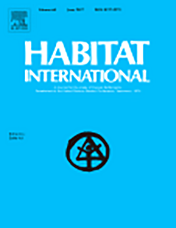Título
Urban driving forces and megacity expansion threats. Study case in the Mexico City periphery
Alias
170501-01-articulo
Portada

Autores
José Mauricio Galeana Pizaña.
Año
2017
Fecha
2017-05-01
Categoría
Artículos
Identificador
ISSN: 1616-5047 DOI: 10.1016/j.habitatint.2017.04.004
Hipervínculo
Hipervínculo revisado
01 Septiembre 2021
Abstract
The megacity proximity produces significant stress in the surrounding areas with fast changes in land conversion, mainly in the urban sprawl growth. The swiftness facilitates studies about land use changes to urban in short-term. The principal boosting urbanization factors, either socioeconomic or physical geographical, are usually identified as the driving forces (DF) to be considered in the regional planning programs and prospective urbanization modeling.
The land-use-change-to-urban (LUCU) phenomenon was studied by Landsat images along the 2000–2014 period in the Northern periphery of Mexico Megacity. The study case was delimited in the Pachuca-Tizayuca Valley, Hidalgo State. Municipalities and the whole area showed high annual urbanization growth rates (2.89%–4.14%) and 3.39%, respectively. The urban area's increase in each unit allowed calculation of three dependent variables as LUCU quantitative descriptors, which were further applied in three statistical approaches. In the first one, multivariate Ordinary Least Squares (OLS) was performed to evaluate the correlation coefficient (R) and the sensitivity factor (?) for the urbanization rate (?14) vs. each socioeconomic or physical factor. In the second one, the urbanization ratio (UR14) vs. independent variables mean values were used in spatial OLS and Geographically Weighted Regression (GWR) analysis. Finally, the third approach applied Cramer's V test based on the number of pixels converted to urban (PUc14) as LUCU descriptor and all independent variables. Cramer test allowed the best factors' analyses, while not all fitted the OLS and GWR requirements. The whole process leads to a methodologic pathway to identify land change DFs to urban use.
The study case acknowledged the following main DF to urbanization: the welfare; the population growth rate; the population proportions of immigrants, scholar age, workers in second and third economic sector; and the distances to quarry stones, schools, urban areas and roads. Cramer's V reach 70.5 accuracy values in the urbanization modeling with the mentioned DFs by the Multi-Layer Perceptron of the Land Change Modeler (Idrisi). The spatial urban area increase in the 2029 year was predicted based on these DFs.
The land-use-change-to-urban (LUCU) phenomenon was studied by Landsat images along the 2000–2014 period in the Northern periphery of Mexico Megacity. The study case was delimited in the Pachuca-Tizayuca Valley, Hidalgo State. Municipalities and the whole area showed high annual urbanization growth rates (2.89%–4.14%) and 3.39%, respectively. The urban area's increase in each unit allowed calculation of three dependent variables as LUCU quantitative descriptors, which were further applied in three statistical approaches. In the first one, multivariate Ordinary Least Squares (OLS) was performed to evaluate the correlation coefficient (R) and the sensitivity factor (?) for the urbanization rate (?14) vs. each socioeconomic or physical factor. In the second one, the urbanization ratio (UR14) vs. independent variables mean values were used in spatial OLS and Geographically Weighted Regression (GWR) analysis. Finally, the third approach applied Cramer's V test based on the number of pixels converted to urban (PUc14) as LUCU descriptor and all independent variables. Cramer test allowed the best factors' analyses, while not all fitted the OLS and GWR requirements. The whole process leads to a methodologic pathway to identify land change DFs to urban use.
The study case acknowledged the following main DF to urbanization: the welfare; the population growth rate; the population proportions of immigrants, scholar age, workers in second and third economic sector; and the distances to quarry stones, schools, urban areas and roads. Cramer's V reach 70.5 accuracy values in the urbanization modeling with the mentioned DFs by the Multi-Layer Perceptron of the Land Change Modeler (Idrisi). The spatial urban area increase in the 2029 year was predicted based on these DFs.

